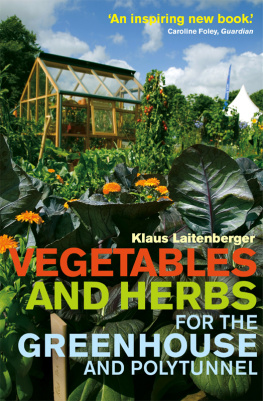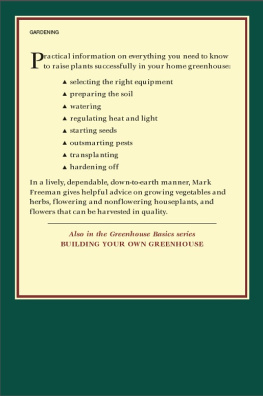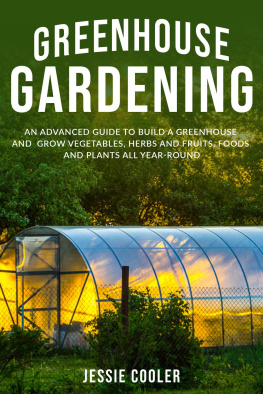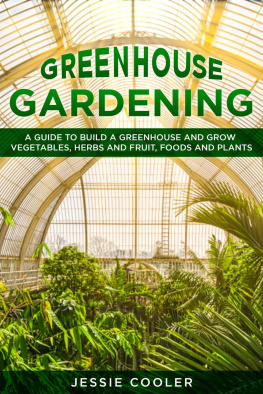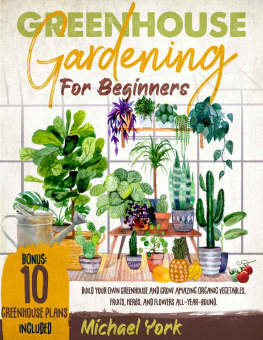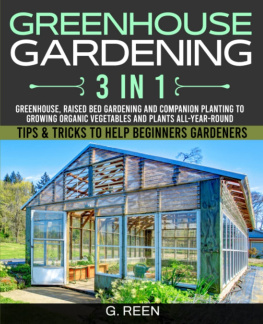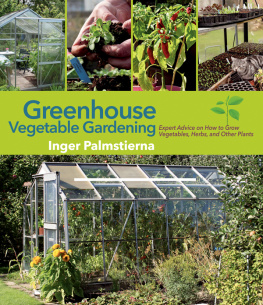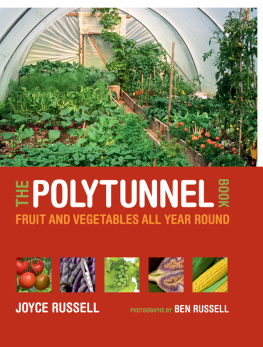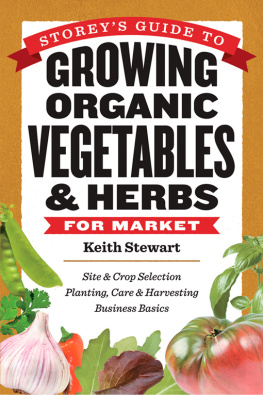VEGETABLES AND HERBS
FOR THE GREENHOUSE
AND POLYTUNNEL
Also in Right Way
Vegetable Growing Month by Month
The Essential Allotment Guide
Vegetable, Fruit and Herb Growing in Small Spaces
How to Store Your Home Grown Produce
Backgarden Chickens and Other Poultry
The Right Way to Keep Chickens
VEGETABLES
AND HERBS FOR
THE GREENHOUSE
AND POLYTUNNEL
Klaus Laitenberger

Constable & Robinson Ltd
5556 Russell Square
London
WC1B 4HP
www.constablerobinson.com
Originally published as Vegetables for the Polytunnel and Greenhouse
by Milkwood Farm Publishing 2012
First published by Right Way, an imprint of Constable & Robinson, 2013
Copyright Klaus Laitenberger 2013
The right of Klaus Laitenberger to be identified as the author of this work has been asserted by him in accordance with the Copyright, Designs & Patents Act 1988.
All rights reserved. This book is sold subject to the condition that it shall not, by way of trade or otherwise, be lent, re-sold, hired out or otherwise circulated in any form of binding or cover other than that in which it is published and without a similar condition including this condition being imposed on the subsequent purchaser.
Illustrations by Dympna Driscoll
Victorian Images Courtesy of Thomas Etty Seeds Esq.
A copy of the British Library Cataloguing in Publication Data
is available from the British Library
ISBN: 978-0-7160-2342-5
eISBN: 978-0-7160-2343-2
Printed and bound in the EU
1 3 5 7 9 10 8 6 4 2
Cover image: RHS Images; Cover design: www.simonlevyassociates.co.uk
To forget how to dig the earth
and to tend the soil
is to forget ourselves
Mahatma Gandi
For Iris
CONTENTS

INTRODUCTION
I have always been passionate about growing food all kinds of it and I have never liked buying food that could be grown in my own garden. Unfortunately in our climate in western Europe there is a whole range of common vegetables that will do poorly outdoors and we need the extra heat and shelter of a greenhouse or polytunnel to get a good crop. Our growing season is very short but with the help of an indoor space we can prolong the production period for all vegetables. We can get an extra early as well as an extra late crop of most vegetables.
I promise you that getting a tunnel or a greenhouse will revolutionize your gardening life. It will open up new avenues, youll experiment with new vegetables and youll be guaranteed a food supply throughout the year. A friend of mine has even an armchair and a radio in his little greenhouse and uses it as his escape. Even if we get a poor summer you can get the illusion that you are in a different country and enjoy the warmth at home.
This book is aimed at anybody who has the wish to grow their own food and Im hoping to encourage readers to experiment. Try out new vegetables, new varieties, new plants that youve never heard of or plants that we commonly use (soya beans, peanuts, ginger) but have never seen growing. This is the fun and excitement of gardening.
I made a conscious decision not to include the technical aspects of erecting a greenhouse or tunnel because there are plenty of excellent instructive manuals available. Im a gardener who loves to grow food and I want to show you how simple it is to become more or less self-sufficient in fresh food. Growing your own food will also give you a sense of purpose and a sense of pride.
For each vegetable youll find very detailed growing instructions. Im an organic gardener and these have worked for me for many years but should not be viewed as a general rule. We all know that each gardener has different growing techniques and youll find out your own best way.
Some people have reservations about polytunnels the aesthetics as well as the use of plastic. Obviously most greenhouses are visually more pleasant than polytunnels but unfortunately more expensive unless you can build your own. Even with plastic for the tunnel covering I think its a lot more environmentally friendly to grow your own fresh organic vegetables in a tunnel rather than importing them from all over the world, for example garlic from China and peas from Peru. In fact, over 80 per cent of all fresh organic vegetables are imported and most of them could be grown here.
Be warned though, once you have tasted your first home-grown tomato there is no way of going back to the factory farmed, sterile Dutch supermarket tomatoes that will never rot, bruise or crack and never taste of anything more than water.
Throughout the book I recommend varieties that I have found the very best in terms of flavour and natural healthy growth. Im an experimenter by nature, but throughout the years of trials I have limited the range of varieties to just a few but this should not stop you from trying out new things. One year I grew 100 varieties of tomatoes in a large polytunnel and all the visitors had to do a taste test. The variety that came out on top was Sungold F1. There is really no better tomato than Sungold F1. You havent fully lived until youve actually eaten one. Unfortunately it will hardly ever find its way into shops or supermarkets because it cracks and bruises easily. It needs to be eaten fresh from the plant.
I hope that this book will be useful for beginners and experienced gardeners alike and that you will soon discover with the help of a tunnel or greenhouse how easy it is to produce good, healthy food for your table. What greater satisfaction can there be?
It is quite amazing how many people are taking up vegetable growing again. In Ireland, where I live, Im a patron of GIY (Grow it Yourself), an excellent non-profit organisation, which promotes growing your own food and showing people how to do it ( www.giyireland.com ).
AUBERGINE
Latin name:Solanum melongena
Family:Solanaceae
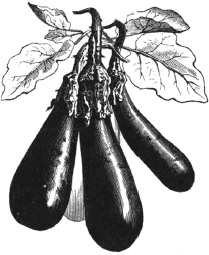
Aubergines have been cultivated in Asia since the fifth century BC. They were introduced to Spain by Arab conquerors in the fourth century AD. By the sixth century they were grown throughout Europe but mainly as an ornamental plant.
Aubergines are known as eggplants in America because the fruits of some varieties resemble eggs. Aubergines come in a wide range of colours, ranging from white, pink, red, purple to black. The shape of the fruit is also variable. It may be egg shaped, elongated or even finger like.
Unfortunately aubergines are a far less reliable crop compared to tomatoes and cucumbers. There is, however, always a space for one or two plants and the flavour of the fruit makes it all worthwhile. The secret of growing good aubergines is to start the seeds off early in the year and to choose a good variety.
SOIL AND SITE
Aubergines benefit from good ventilation so you may plant them close to the entrance. They require a fertile soil so plenty of mature compost or well rotted manure should be incorporated.
SOWING
Aubergines should be started off very early in the year as they require a long growing season. The best time to sow the seeds is from mid February until mid March at the latest. I usually sow the seeds in a small standard seed tray or pot and space the seeds about 2cm apart from each other. The tray should be placed into a warm propagator or on a warm windowsill. The temperature should be around 1821C. The seedlings start to appear within 710 days. About a week after they have germinated they should be pricked out into 7cm pots using potting compost. About 34 weeks later they can be potted on into a 10cm pot.

